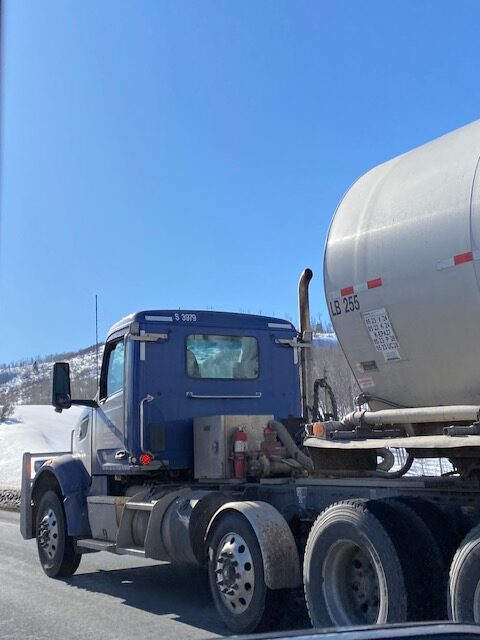Air quality assailed by Colorado opponents of Uinta Basin oil-drilling expansion in Utah

An oil truck on U.S. Route 191 through the Uinta Basin in Utah in February of 2024 — the alternative to building the Uinta Basin Railway project (David O. Williams photo).
While much of Colorado’s consternation about the flood of Utah waxy crude oil coming our way if the Uinta Basin Railway is ever built – or even if it isn’t — has centered on the Colorado River and the potential downstream impacts of inevitable train derailments and oil spills, turns out being downwind could be just as perilous, according to environmental groups and lawmakers.
Colorado U.S. Sen. Michael Bennet and U.S. Rep. Joe Neguse, whose district includes Vail and most of Eagle County, this week fired off a letter to U.S. Environmental Protection Agency (EPA) Administrator Michael Regan expressing concerns about the impacts of air pollution from the proposed expansion of three Utah railroad “loadout” facilities for Uinta Basin oil.
Viewed as a “Plan B” if the (for now) legally derailed 88-mile Uinta Basin Railway never gets built, the expanded Wildcat Loadout, Price River Terminal and Savage Energy Terminal would allow up to 260,000 barrels of Uinta Basin oil to be shipped on the national rail network every day through Colorado (the Bennet-Neguse letter erroneously stated 260,000 barrels a year).
The Uinta Basin Railway, which Eagle County and several environmental groups successfully sued to at least delay last year (pending a referral to the U.S. Supreme Court), was projected to increase the amount of oil coming through Colorado on the way to Gulf Coast refineries to 350,000 barrels a day from the current level of 90,000 barrels per day.
“These trains run for over 100 miles alongside the Colorado River’s headwaters – a vital water supply for nearly 40 million Americans, 30 tribal nations and millions of acres of agricultural land,” Bennet and Neguse wrote on Monday. “We urge the Environmental Protection Agency (EPA) to carefully examine and address potentially flawed air pollution permits that have been issued or are under consideration in Utah for these facilities in and near the Uinta Basin.”
A barrel of Utah waxy crude, too viscous to be moved to Gulf Coast refineries via pipeline, contains 42 gallons of oil, which comes out to just under 4 billion gallons a year at the rate of 260,000 barrels per day. Opponents say that’s a huge jump in carbon pollution at a time when the global climate crisis is accelerating by the day.
“As oil transport by rail increases, the risk of spills and other incidents also increases,” the two Colorado Democrats wrote. “A train derailment that spills oil in the Colorado River’s headwaters would be disastrous to our state’s water supplies, wildlife habitat, and outdoor recreation assets, and the broader Colorado River Basin. In addition, an accident on the train line further increases wildfire risk at a time when the West already faces historically dry conditions.”
Utah waxy crude must be shipped in heated tanker cars to keep it from solidifying.
The lawmakers go on to argue that the expansion of the three loadout facilities on the existing rail network get Utah oil producers three-quarters of the way toward the target of their railway project, which was sent back to the drawing board by a federal appeals court for more environmental review. Currently, the oil is being trucked to the train tracks on local roads.
The three loadout facilities – one of which RealVail.com first covered in July of last year – are near the national rail network approximately 90 miles from the Uinta Basin oil fields. The Savage Terminal and the Price River Terminal are seeking new air quality permits from the state of Utah in order to expand, and the Wildcat Loadout was recently awarded its permit despite ongoing violations, as detailed late last year by RealVail.com.
“It is unclear whether these applications or permits adequately address the potentially significant air pollution that would result [from the expansions],” Neguse and Bennet wrote. “We urge EPA to examine whether these applications or permits are based on erroneous assumptions about emission control effectiveness and enforcement.”
The applications for Price River and Savage terminals promise a 95% reduction in harmful emissions either by flaring, or burning off (at Wildcat and Price River), or by vapor balance control while filling tankers at the Savage Terminal. But the lawmakers argue the permit and applications don’t require monitoring, testing, or operational and maintenance practices. That’s something that’s been a red flag for the EPA in the past, they add.
Asked about the Bennet-Neguse concerns, an EPA spokesperson on Tuesday wrote in an email, “EPA will review the letter.” The agency then addressed a proposed EPA extension for the state of Utah on ozone attainment in the Uinta Basin, per the Federal Register.
“EPA proposed, in the Federal Register, a determination that air quality in the Uinta Basin attained the 2015 Clean Air Act ozone standard based on an extension of the attainment date to 2023, and on monitoring data collected from the basin in 2020, 2021 and 2022,” Kerri Fiedler of the EPA’s Air & Radiation Division wrote in an email, noting public comment closed on May 10. “EPA will continue to work with the state of Utah and the Ute Tribe to evaluate compliance with recent Clean Air Act requirements for production sources and to assess air quality conditions in the Basin, including monitoring for ozone and methane emissions.”
Separate from the overall emissions issues addressed in the Bennet-Neguse letter, Jeremy Nichols of the environmental group Center for Biological Diversity – one of the groups that successfully sued to force more environmental review of the Uinta Basin Railway – wrote in an email to RealVail.com that the ozone levels in the oil fields of the Uinta Basin in 2023 exceeded that of the Denver metro area, which has violated ozone standards for years.
“What are the implications of the [EPA] proposal [to grant Utah an extension]?” Nichols wrote. “While the region will still be designated a nonattainment area, the Uinta Basin won’t be ‘bumped up’ from a marginal to a moderate nonattainment area. If it was bumped up, it would face more stringent air quality regulatory requirements and additional deadlines for Utah to clean up the mess. Unfortunately, that won’t happen. EPA’s action essentially puts the Uinta Basin in ozone purgatory. It will let the state of Utah off the hook for doing anything more to clean up the smog and allow the Uinta Basin to violate the ozone standards in perpetuity.”
Nichols adds that there are implications for the oil-train proposal as well.
“The unfortunate thing is that this will definitely make it easier for the Uinta Basin railroad to be resurrected,” Nichols added. “The EPA’s proposal will make it easier for the oil and gas industry to ignore the ozone problem and face no repercussions for making the problem worse.”
Here’s the full text of the Bennet-Neguse letter to the EPA on air-quality issues and the loadout expansions:
Dear Administrator Regan,
June 11, 2024
We write to share our concerns regarding how the proposed expansion of three oil loading facilities in Utah will affect Colorado’s communities, water, land, air, and climate. Expansions for the Wildcat Loadout, the Price River Terminal, and the Savage Energy Terminal would enable up to 260,000 barrels of oil to be shipped every year [sic] by rail through Colorado. These trains run for over 100 miles alongside the Colorado River’s headwaters – a vital water supply for nearly 40 million Americans, 30 Tribal nations, and millions of acres of agricultural land. We urge the Environmental Protection Agency (EPA) to carefully examine and address potentially flawed air pollution permits that have been issued or are under consideration in Utah for these facilities in and near the Uinta Basin.
As oil transport by rail increases, the risk of spills and other incidents also increases. A train derailment that spills oil in the Colorado River’s headwaters would be disastrous to our state’s water supplies, wildlife habitat, and outdoor recreation assets, and the broader Colorado River Basin. In addition, an accident on the train line further increases wildfire risk at a time when the West already faces historically dry conditions. We previously raised similar concerns regarding the proposed Uinta Basin Railway in Utah, which would ship up to 4.6 billion gallons of waxy crude oil per year through Colorado. Last summer, a federal court overruled the Surface Transportation Board’s (STB) decision to approve the project, which was based on a deeply flawed environmental and risk analysis, and ordered a new review.1 While plans to construct a new railway have stalled, expanding these loading facilities would enable the shipment of nearly 75% of the oil proposed to be transported through Colorado if the Uinta Basin Railway were to be completed.
The Savage Terminal and the Price River Terminal are seeking new air quality permits from the State of Utah to facilitate their expansions, and the Wildcat Loadout was recently awarded a permit to do the same. It is unclear whether these applications or permits adequately address the potentially significant air pollution that would result. We urge EPA to examine whether these applications or permits are based on erroneous assumptions about emission control effectiveness and enforcement.
In all three cases, the application or permit assumes that harmful emissions will be reduced by more than 95% with the use of flaring (in the case of the Wildcat Loadout and the Price River Terminal) or a vapor balance control system (in the case of the Savage Terminal). However, the final permit for the Wildcat Loadout, the proposed permit for the Savage Terminal, and the application for the Price River Terminal include no requirements for monitoring, testing, or operational and maintenance practices that would assure the assumed levels of emissions reductions actually occur.
The EPA has previously objected to similarly inadequate permits on the basis that without testing and regular monitoring of control efficiency from control devices, such as a flare, it is not reasonable to assume compliance at oil and gas handling facilities.2 Accordingly, we urge EPA to examine these proposed loadout expansions and ensure their permits are enforceable and will effectively limit harmful emissions.
We look forward to hearing from you on this important matter.
Sincerely,
Michael F. Bennet United States Senator and Joe Neguse
1 Eagle County, Colo. v. Surface Transportation Board, — F.4th — (D.C. Cir. Aug. 18, 2023).
2 See: In the Matter of Bonanza Creek Operating Company, LLC, Order on Petition No. VIII-2023-11 at 13-15 (Jan. 30, 2024) and In the Matter of DCP Operating Company, LP, Order on Petition No. VIII-2023-14 at 11-13 (April 2, 2024). The findings presumed 95% volatile organic compound control efficiency for oil and gas processing facilities in Colorado was not supported by adequate monitoring.


Latest posts by David O. Williams (see all)
- Democratization or ruination? A deep dive on impacts of multi-resort ski passes on ski towns - February 5, 2025
- Western Rail Coalition looks to revive passenger rail service on long-dormant line connecting Colorado mountain towns - January 22, 2025
- Colorado ski town looks to dig deep, diversify energy sources as climate change threat looms - January 10, 2025

You must be logged in to post a comment Login